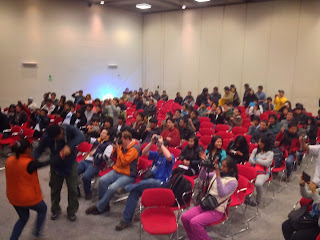Pre-FUDCon
While we were waiting of Lima's airport, we met Juan Barba. We agreed to meet in Cusco. Finally, we landed at the International Airport Alejandro Velasco Astete. At that moment I thought: I'm in Cusco, it's time to work!
We were received by Cesar Villacorta and Eduardo Echeverria. Cesar is one of the main organizers of the event. A great guy, very helpful, he guided and accompanied us during our stay in Cusco.
We drove to the apartment where we were staying for the night, as they finished to get everyone to come together at the hotel Antawasi. The department was very comfortable. There we worked on our presentations and talked about our expectations of the event.
That night I participated, along with Eduardo, a 30-minute interview for Solar TV channel. At that time we promote the project and highlight the relevance of FUDCon for the people of Cusco.
The next day we all met at the hotel Antawasi, a place that would be the operations base for the Fedora community. Everything was fine except for the internet bandwidth that was not enough.
This day was used to settling into the hotel, walk the town and end our presentations. Somewhat surprising was the architecture. The buildings keeps the old colonial style. Even places as KFC and McDonald's respected the style.
Also went to the convention center of the Municipality of Cusco to see that all the technical part was working properly for the event. We reviewed all the rooms we had available and the different capabilities that each offered.
That night we shared the initial event dinner in the restaurant Ima Sumaq. After that, at the hotel, we saw the final details of the event such as posters and promotional media. A big concern that we had was that next day was to be given a transport strike.
First Day
Passed only a few minutes when we got a lot of people, approximately 900 people were around. The great room was filling with people who were eager for knowledge.
The event began with the national anthem, the welcome words from the dean of the college, the mayor of Cusco and Jared Smith as Fedora Project Leader representation.
Particularly, the mayor's words were very moving. He said a few words in Quechua (Inca native language) that were taxed in the minds of all who attended the event: Qosqo Kausachun! (which means "Long live Cusco!").
Then he gave badges and books in gratitude for attending the event. I want to highlight the hard work of local partners. They were always attentive to the details that were needed at the time.
Later, we all introduced ourselves. We indicate our countries of origin and the work we have in the Fedora Project. At the event were over 20 contributors from different countries: Nicaragua, Panama, Venezuela, United States, Brazil and Argentina.
Then he gave badges and books in gratitude for attending the event. I want to highlight the hard work of local partners. They were always attentive to the details that were needed at the time.
Later, we all introduced ourselves. We indicate our countries of origin and the work we have in the Fedora Project. At the event were over 20 contributors from different countries: Nicaragua, Panama, Venezuela, United States, Brazil and Argentina.
Followed by the substantial point of the event: BarCamp. This time I explained to the participants what is an unconference event and the instructions that would follow in the event. Then the people came to propose their presentations. In total there were about 65 proposals for lectures and workshops.
Second Day
Third Day
On this day I was able to deliver two presentations. The first was about MariaDB Galera Cluster, its features and benefits, including a demostration. The second presentation was about the concept of Big Data in Fedora, how it works and why it is special. Also I set up a demonstration using Elasticsearch, Kibana and Logstash.
At noon, we moved to a restaurant called El Palacio del Inca where we shared lunch with the principal of the Universidad Nacional de San Antonio Abad of Cusco. He expressed his deep gratitude for our presence in Cusco and the relationship of free software with the Inca culture. In the end he shared some gifts and made a toast.
We then returned to the convention center to end the presentations and close the event. Despite being the last day, the attendance exceeded 250 people. When we shut down the event, each of us gave a word of thanks and shared our contact details.
At the end, local contributors showed us some inca dances. Everybody was taking pictures. People were happy. Even Dennis Gilmore was dacing. It was a successful event.
Then we shared dinner in the restaurant Ima Sumaq. People were more relaxed, happy for all the achievements obtained, considering the challenges to be overcome on next FUDCon.
FUDPub
We got up early to find transport to take us to the village of Urcos.
That's where we would be celebrating FUDPub, living the Inca Worship to the Water Festival, organized by the municipality of this place.
We lunch together and play football. Then we went to the ruins of Pikillaqta. At the end of the day we returned to the hotel and we prepared our bags to return to our respective homes.
We then returned to the convention center to end the presentations and close the event. Despite being the last day, the attendance exceeded 250 people. When we shut down the event, each of us gave a word of thanks and shared our contact details.
FUDPub
Post-FUDCon
See you at the next FUDCon!



































